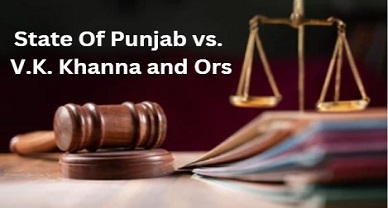State Of Punjab vs. V.K. Khanna and Ors. Civil Appeal 6963 Of 2000
INTRODUCTION
The principles of natural justice are classified into audi alteram partem (hear the other side) and nemo judex in causa sua.[1] The case in hand deals with the concept of “Nemo judex in causa Sua” which means that “no one should be a judge in their cause”, also “Rule against bias.“[2].
The dispute stands between the “last phase of the earlier government” and the “initial phases of the then-present government” in “Punjab”. CBI Proceedings were initiated against senior colleagues by the “former Chief Secretary of Punjab” after having taken approval from the then “Chief Minister of Punjab” under “Section 6 of The Delhi Special Police Establishment Act, 1946[3]“. But with the coming of new Government and “Shri Prakash Singh Badal” being the “Chief Minister” a lot of changes occurred. Previous Chief Secretary left his administrative office and a new Chief Secretary was appointed for the state. Within 10 days of his arrival, a notification was published. The notification revoked the previously issued two notifications which pertained to the initiation of the Central Bureau of Investigation inquiry against Shri Bikram Jit Singh, IAS. The earlier notifications were issued by the then Chief Secretary, Mr. V.K. Khanna on the orders of the then Chief Minister. The charges were imposed on Bikram Jit Singh, IAS alleging him of possessing land in Wazidpur village and which had been added to the assets possessed by the officer. This purchase exceeded his known source of income. Further, he was charged for “allotment of land and funds to the Punjab Cricket Association”. The government changed after fresh elections and soon after V.K. Khanna was charged with various offences. The charges comprised of him possibly acting with malicious and mala-fide intent, violating procedures established by government and service rules. The charges also indicated “lack of fairness and integrity” on his part and that he was disobedient for not complying with the high moral standards that are expected from a civil servant. The respondent contested the chargesheet issued to him before the “Central Administrative Tribunal, Chandigarh”. But the tribunal asked him to file a reply to it first[4] which would further be looked into by the disciplinary authority and eventually provide him to present his concerns. The application was dismissed by the tribunal. The case was bought in the High Court wherein they concluded that this was an “unjust, arbitrary and malicious” move towards respondent and therefore the chargesheet was set aside. Therefore, an appeal was filed in the SC via “grant of special leave” because appellants felt that the chargesheet instead of being quashed should have been confirmed by the HC.
ISSUE
- Whether the act of issuance of Charge sheet be said to be disproportionate?
- Was the respondent guilty of the charges imposed on him?
RULE
- Constitution of India
- Article 51-A, 14
- Delhi Special Police Establishment Act, 1946
- Section 6
ANALYSIS
The idea of fairness in matters of “administrative action” has always been a matter of great significance and determination for the courts. But when it comes to the fundamental aspect of this notion, there is consensus on the fact that it hinges on two aspects, that is facts and circumstances which vary from case to case. There is no straitjacket or rigid formula. Fairness can be equated to reasonableness and to determine the meaning of reasonableness, one has to consider the perspective of a prudent man who has faced a similar situation. And this is what prompts the court to evaluate if this understanding of reasonlessness applies suitably. Likewise, to identify the presence of malice or prejudice in actions there is no rigid set of rules, and varies from case to case. The idea of bias falls within the “attributes and purview” of the term “malice” which has a broader scope. In common parlance, the term “malice” means “spite” or “ill-will”. Just by making general statements it cannot be inferred that someone did an act out of ill will. Cogent and solid evidence on record is the “sine qua non” to conclude that there indeed existed some biases, and malicious intention, which led to miscarriage of justice[5]. The appellants did not provide any cogent evidence against the respondent which shows a mala fide move on their part.
In legal investigations, intention is the crucial element which stands on a different footing from “motive”. A “malicious act” can be considered equal to an “intentional act” without there being any valid or reasonable justification[6]. Bias hinges on the test of whether there is “mere apprehension” or “actual, real danger” of bias, and to evaluate this, the surrounding circumstances must be considered and an appropriate conclusion shall be made on that basis. If the test indicates the existence of “actual, real danger” of bias, the validity of “administrative action” cannot be upheld. Contrary to this, if the allegations turn out to be fanciful assumptions, the administrative actions need not be considered as not viable[7]. Biasness erodes the very idea of fairness and reasonableness which is the cornerstone of “principles of natural justice” and violates “Article 14 of the Indian Constitution[8]“. As a result, “arbitrariness and mala fide move” walks in. Even though the two notifications were assumed to be issued in “hot haste”, no specific evidence was presented in the records which would indicate malicious intent on the respondent’s part. The word “mala fide” holds a definite legal understanding; its meaning cannot be derived from mere apprehensions or fancy imaginations. Concrete proof of the existence of bias and acts not carried out in good faith is the essence. However, just because an act lacks good faith does not automatically make it mala fide, until they are accompanied by other factors which would showcase “bad motive or intent” on the doer’s part. There was no such element demonstrating the fact that the respondent did have a “bad motive, intent”.
It was the Chief Minister’s wish to inspect the files of two senior officers in the normal course of his workings. The Chief Secretary while working under his duty gave suggestions for further investigation. In the absence of evidence of personal conflict or other supporting proof, this act alone cannot be said to be maintainable to bring out malicious intent. There arises no issue just because the Chief Minister agreed to the decision and it led to an unbiased investigation. In the absence of concrete proof of personal grudges, the claims stand to be legally insufficient. Administrative actions can be discredited as arbitrary only based on solid evidence. Prima facie ill will be the essence, in the absence of which the act would be unfair and not within the walls of legal principles. Post review, files, and evidence did not support the allegations. Also, just because the respondent initiated an investigation against an officer does not make him guilty of breaching the procedures established by the government. Neither does the court disregard the act of initiating an inquiry against an officer for possessing assets more than his known source of income, to be a “violation of service rules or principles of fairness, integrity and ethics”. Moreover, it was the Chief Minster himself who wanted the reference to be made “immediately” according to his note dated 24.06.1997″. Hence, it cannot be objected that it was the respondent who acted in “undue haste and interest” while handling the case.
Although there is no dispute as to the fact that courts cannot interfere to assess the validity of charges while initial disciplinary proceedings are in process, it is a fact that where there is evidence of malicious intent of the authority and that the inquiry is a “mere show with no fair conclusions” the courts have the jurisdiction to step in promptly, for they have the power of “judicial review[9]“, to prevent “harassment and humiliation of public official”. “Article 21 of the Indian Constitution[10]” sets out that the “procedures established by law” be just and fair. And fair hearing ought to be included in that procedure.
The announcement made by the new Chief Minister in the press about the “appointment of inquiry officer” could not be said to be an indicator for “fair and impartial attitude” towards the officer involved. This indicated “a certain mindset or predisposition” as it was made even before the reply was filed. Service jurisprudence speaks for applying of authorities’ minds’ once they receive the “reply of the charge-sheet or the show-cause”. On careful consideration, if they find it necessary, an inquiry is followed, otherwise not.
The appeals were therefore dismissed, and the charges framed against the respondent were set aside as they were mala fide, baseless, and biased.
CONCLUSION
Owing to the expansion of the “modern state”, Administrative law has taken a great leap and has been consistently evolving. “Rule against bias” serves as a check and balance against the decision-makers who are involved in complex administrative activities. The dual aspects of it would have to be looked into i.e., “real likelihood ” or “mere suspicion” of bias to ascertain if the administrative action was vitiated or not. To safeguard the basic structure of our Constitution, the courts with the power of judicial review can intervene in administrative actions in case they sense some arbitrariness and mala fide intent on the part of decision-makers to ensure that the basic fundamental rights of a citizen enshrined under the golden triangle do not get violated and further that “principles of natural justice” are not hampered.
Author: Anavi Jain and Sonakshi Pandey, in case of any queries please contact/write back to us via email to chhavi@khuranaandkhurana.com or at Khurana & Khurana, Advocates and IP Attorney.
[1] EDEKO, S. E. , The Protection Of The Right To Fair Hearing in Nigeria. Sacha Journal of Human Rights (2023).
[2] Sanjayan Rajasingham, Reforming the Rule against Bias in Administrative Law, 3 CALJ 28 (2017).
[3] The Delhi Special Police Establishment Act, 1946, S 6, No. 25, Acts of Parliament, 1946 (India).
[4] Union of India v. Ashok Kacker, 1995 SCC (L&S) 375.
[5] Kumaon Mandal Vikas Nigam Ltd. V. Girja Shankar Pant, (2001) 1 SCC 182.
[6] Jones Brothers (Hunstanton) Ld. v. Stevens, 1955(1) Q.B. 275.
[7] Franklin v. Minister of Town and Country Planning, 1948 AC 87.
[8] INDIA CONST. art. 14.
[9] INDIA CONST. art. 226.
[10] INDIA CONST. art. 21.


